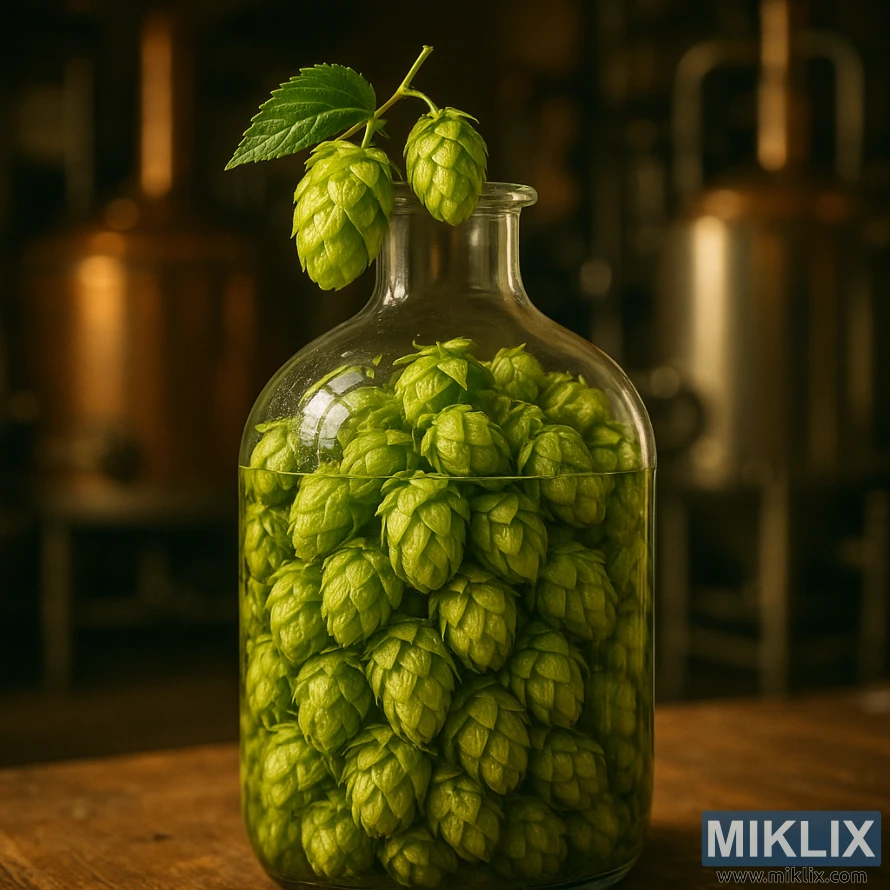Image: Dry Hopping with Fresh Hops
Published: August 29, 2025 at 8:05:03 AM UTC
Last updated: September 26, 2025 at 9:19:57 PM UTC
A glass vessel with vibrant hops cones under golden light, highlighting the artisanal craft of dry hopping in traditional beer brewing.
The photograph captures a moment where simplicity and craft meet, presenting a striking still life that tells a layered story about brewing and its reliance on one of its most vital ingredients: hops. At the center stands a large glass vessel, its curved body filled nearly to the brim with lush hop cones. Their tightly layered bracts, glowing in vibrant shades of green, press against the transparent walls of the vessel, creating a mesmerizing pattern of natural geometry. Each cone appears plump and fresh, hinting at the golden lupulin hidden inside—the resinous treasure that carries the aromatic oils and bittering compounds essential to beer. The transparency of the glass allows these details to be fully admired, transforming the vessel into both a container and a showcase. Its polished surface reflects subtle glimmers of warm light, adding depth to the scene while emphasizing the purity of the ingredient it holds.
Perched on the vessel’s narrow neck is a sprig of freshly cut hops, its cones still attached to a small section of bine and leaf. This detail softens the composition, introducing a touch of the field into the otherwise controlled indoor setting. The fresh hops balance delicately atop the glass as though inviting the viewer to imagine their fragrance—bright citrus notes mingling with piney sharpness and faint herbal undertones. The leaf, still supple and green, underscores the immediacy of the harvest, reminding us that before the cones are sealed away in jars or added to fermenters, they are living plants tied directly to the soil and the care of those who cultivate them. This juxtaposition—fresh sprig above, preserved abundance below—symbolizes the bridge between agriculture and brewing, between raw potential and crafted result.
The background, intentionally blurred, situates the vessel within the broader context of a working brewhouse. The faint outlines of copper brewing kettles and stainless steel fermenters rise in the soft shadows, their warm metallic tones echoing the golden light that bathes the hops in the foreground. These hints of equipment, though indistinct, ground the image in tradition, reminding us that hops achieve their full expression not in isolation but in concert with malt, water, yeast, and the careful hands of a brewer. The rustic wooden surface on which the vessel rests further adds to this sense of place, tying the image to artisanal craft rather than industrial sterility. It suggests a workspace where ingredients are respected, measured, and transformed with care.
The mood is warm, contemplative, and reverent, achieved through lighting that drapes the scene in golden tones. Shadows fall softly, highlighting textures without overwhelming them, and the interplay of light and glass creates an almost sacred aura around the vessel of hops. It feels as though the photograph is not just documenting a stage in the brewing process but elevating it, capturing the artistry inherent in even the most functional acts of preparation. The hops, cradled within their glass home, become more than an ingredient—they are the essence of flavor, the lifeblood of aroma, the promise of beers yet to come.
Altogether, the composition communicates the importance of hops in brewing, not as a mere additive but as a cornerstone of taste and identity. From the fresh sprig perched on top to the mass of cones submerged in the vessel, and from the faint brewing equipment in the background to the soft wood beneath, every detail speaks of connection—between land and brewer, between ingredient and technique, between tradition and innovation. It is a celebration of the humble hop cone, reminding us that within its layered bracts lies the power to transform simple wort into beer with soul, character, and story.
The image is related to: Hops in Beer Brewing: Aquila

